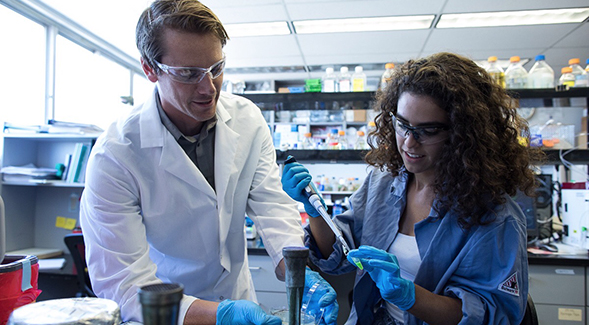For this Recent Grad, Roots in STEM and Growth in a Lab
Milagros Esmerode chose SDSU over other universities because she found it offered more student resources for success.

Her mother is a physicist and her father a chemist, so Milagros ‘Mimi’ Esmerode was encouraged to explore STEM while growing up, but she paved her own path to biology.
Her family moved around before settling in Benicia, a small town in the San Francisco Bay Area. Today Esmerode is a proud San Diego State University alumna who graduated in May with a degree in cell and molecular biology and is now pursuing her Ph.D. in the same field at the University of California, Santa Barbara.
While at SDSU, an enterprising Esmerode started a blog with a fellow Aztec, Mikayla Krzmarzick, called Rooted in STEM. It explores choices and challenges for STEM students as they plot and plan their careers, offering personal perspectives and insights. The practical posts range from how to pass organic chemistry to securing summer internships, and deciding if doctoral studies are right for you.
Esmerode shared with the SDSU News Team the research experience she gained in marine microbiologist Nick Shikuma’s lab, and her relationships with her mentors were a big part of her time at SDSU that will continue to define her future.
Why did you choose SDSU?
There are so many reasons why I chose SDSU. I was initially torn between SDSU and a UC (University of California). I remember everyone would say that when they stepped on campus they just knew it was the right one for them. I toured many campuses and ultimately chose SDSU because I got the sense that there were many resources available to help undergrads, especially freshmen and sophomores, succeed in their classes. The math learning center and Supplemental Instruction (SI), a student facilitated study program, are the first two that come to mind. I also liked that while research was valued at SDSU, the professors were motivated to teach, unlike at many other research universities. I also loved the idea of staying in California and living in San Diego.
How did you learn about the research opportunity with Professor Shikuma?
Since both my parents conduct research, I knew undergrads could volunteer or work in research labs to see if they enjoy it. I found Dr. Shikuma on SDSU’s biology department’s faculty page and reached out to him at the end of my sophomore year to discuss joining his lab at the start of my junior year. I knew that regardless of what I ended up choosing to do after my bachelors degree, I needed to explore the world of research to see if I could envision doing research for a career.
What did you work on in his lab?
When I joined the Shikuma lab I was assigned to Ph.D. student Kyle Malter, as my mentor. He taught me the basics and I assisted him in his doctoral project.
The lab studies the interaction between a marine tubeworm and a marine bacterium which helps this tubeworm undergo metamorphosis and grow into its adult form. Kyle’s project was focused on the molecular mechanism that occurs in the tubeworm larvae when it interacts with the marine bacteria. My biggest contribution was completing replicates of an experiment that Kyle needed for his paper.
How was the experience and what are some insights you can share with students considering research?
I absolutely loved my time in the Shikuma lab. When I graduated I was more upset that I was leaving the lab than the fact that I was done being a student at SDSU.
I think I learned the most valuable lessons in the lab. Doing hands-on research allows you to apply the knowledge you learn in the lecture halls in a real-life setting and cover much more than you learn in a lecture. Even on a slow day I was in an environment surrounded by other scientists who were happy to talk about science. I found it was intellectually stimulating.
By the end of my degree, I felt like I had created a small community that I was a part of. Being in the Shikuma lab helped me feel like I belonged in science (I write a lot about my takeaways and the experiences I had in the lab on my blog rootedinstem.com ). My advice to any student in STEM is to give it a try. No one is born knowing how to do things, so now is the time to learn!
Did your time in the lab lead you to choose your current path?
The mentoring I received while conducting research has helped me become the scientist I am. I have had three different research experiences with very supportive mentors who were Ph.D. students or faculty. They made me comfortable in asking questions. For instance, Amanda Alker, a doctoral student in the Shikuma lab, took on the role of a mentor and helped me with my Ph.D. school applications - something I will forever be grateful for. Being in different labs, seeing graduate students doing their research, being able to talk with them about how they got into science made me realize that I wanted to keep learning and to continue doing research in academia.



